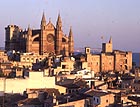Life and Sol of the Balearics
There is far more to the Balearic Islands than is commonly perceived: Arabella Youens sheds new light on these surprisingly varied isles.


Do Andrew Lloyd Webber, Claudia Schiffer and Michael Douglas know something about Spain that the rest of us don't? They have all bought houses in the Balearic Islands, once thought of as the ultimate package tourist destination but whose capital, Palma, was recently voted, by the readers of El Pais, as the best place to live in Spain. The island authorities are out to perpetuate this trend, with an advertising campaign that seeks to position them as ?te, sophisticated and different from each other, rather than uniformly sangria-swigging and cheap. Admittedly, localised patches of over-development occur throughout the islands, but otherwise they are surprisingly diverse: from the rolling pastureland of Menorca, to the purple-grey mountains in Mallorca, the terraced olive groves of Ibiza's interior to the turquoise-fringed bays of Formentera. Historically, the Balearics have been used as pawns in the various Mediterranean power struggles, the stories of which are told through the varying architectural styles and linguistic idiosyncrasies bequeathed to the local dialects of Catalan. Canny expats who have made the islands their home agree: apart from weaving a rich tapestry of cultural influences, the experience has carved a people robust enough to accept and even appreciate the various 'invasions' of foreigners who have washed up on their shores. Mallorca Variously called the 'golden' or 'tranquil' isle, the largest of the Balearic Islands is perhaps the most sophisticated, certainly the richest, and home to a cosmopolitan group of writers, philanthropists-and members of the international jetset-who have marked Mallorca's position on the world's art, literary and glamour maps. Light years away from the maddening sounds of the sun-sea-sand trio for which the island is famed, those 'in the know' dwell in rural villages scattered across Es Pla, the flat central plain, liberally sprinkled with almond, olive and carob trees, teased out of the clay-court red earth. And in houses perched, by feats of architectural genius, among the steep and winding valleys of the Tramuntana mountains, surrounded by citrus fruit groves and wild herb gardens. Well before the package tourist boom exploded on the island in the late 1950s, Mallorca had already gathered a loyal following. The Austrian Archduke Ludwig Salvator, whose elder brother, Ferdinand, was assassinated in Sarajevo, has been credited with 'discovering Mallorca' in the late 19th century. After falling in love with the island, he purchased a tract of land in the mountains, on which he built and restored a number of possessions (country houses) revered today as cultural and scenic centres. 'Even in the 1920s Mallorca was attracting quite a few foreign intellectuals. It wasn't exactly on the grand tour but it wasn't too far off the beaten track either,' explains Tom?Graves, whose father, Robert, was persuaded by Gertrude Stein to retire there for health reasons. Born and brought up on the island, Mr Graves has developed a sensitive eye to the cultural impact of foreigners who have made Mallorca their home. 'In the early Nineties, Mallorca lost its image of a char-ladies island and it became hip among foreigners, especially Germans, to buy up old fincas. In response, I wrote a handbook designed to help people who were living within the rural system but who still had an urban mentality.' Of the many international communities resident on the island, the German influence is somewhat jaw-dropping: flight boards at the airport are crammed with names of German towns, a weekly German- language island newspaper is published, and bread shops are as likely to sell a dark rye loaf as they are a pan pag? Everyone I spoke to, however, said the monopoly was loosening. 'It seems as though the German presence is on retreat,' says John de St Jorre, an English writer who this year is celebrating his 40th anniversary of com- ing to the island. 'A German friend has recently sold his house to Lord Lloyd- Webber and an English estate agent has just opened up in Dei? (Dei?s a mountain village home to one of the island's most charming hotels, La Residencia.) Several factors-some more substantiated than others-could explain this: a weakening German economy; price hikes following the introduction of the Euro; and unhappy disclosures made by the newly improved lines of communication between the Spanish and German tax authorities. After 40 years of generating immense wealth off the back of cheap-and-cheerful holidays, Mallorcans are now recognising the need to revisit their tourism strategy. Although an 'ecotax', introduced last year to help fund environmental and heritage projects is to be removed, the newly appointed director general of tourism, Eduardo Gamero, assured me: 'We're going to do all we can to limit growth and protect the environment in the Balearics. This remains the Government's top priority.' Planning decrees have tightened: anyone with land classified as 'rural' cannot build a tennis-court and new houses must be clad in stone using local cement. 'And, if you have a sizable plot of land, the government insist that you employ people to look after it correctly,' added Britta Pl?e, as we sat, surrounded by heady clumps of wild rosemary and fennel, on the terrace of her father's rural hotel, Ca's Xorc. 'They mean it too: they come round twice a year to check.' Mallorcans certainly have a propensity to naval-gaze for which they should be gently teased, but pride in their heritage is entirely justified: the local cuisine is delicious, the wines are a nascent success and for a city of its size, Palma brims with culture, its skyline dominated by the immense Gothic Sa Seu cathedral. Furthermore, the artistic consciousness of the island is highly developed, with only a few villages unable to boast some space dedicated to art. 'Mallorcans are very receptive to modern art,' says Baroness Friesen, who spends half the year living at her 18th-century mill house in the north of the island, 'And it's art with a capital A.' Formentera Hanging as though by a thread, 7km south of Ibiza, lies a tiny scrap of an island known as the 'lesser Balear'. Aficionados believe it is the Mediterranean's only convincing stab at paradise, and I would have to agree. Wild and rugged, with no airport, few hotels, hardly any tarmac and a small, if fledgling, nightlife, the island is a celebration of that uncluttered simplicity which is so elusive on its big sister neighbour. Locals, however, stress that the island is not suspended in a time warp. 'The change is so dramatic in some ways, it's hard to describe,' explains Bill Wright, a British architect resident on the island. 'When we came in 1967, there was no electricity on the island, just a generator, one telephone, two lorries and perhaps three taxis. It was like walking into another century.' Today, the number of BMWs and 4x4s are testament to the progress which has been made from a time when it was considered fortunate to earn 1 peseta a day working on the island's salt mines. It is still possible to see cameos of rural Formentera-old ladies dressed in voluminous black skirts which drop from chest height, their necks clad in hand-me-down emprendada gold jewellery. 'But that will only last a few more years,' Mr Wright estimates. Criss-crossing the island are hundreds of camins verts, narrow, sandy lanes marked out by dry stone walls which acutely distinguish the landscape of Formentera from the other islands. 'Very often the youngest child inherits half the land and the rest is then divided up between the other children, which ex- plains why the land is so parcelled up here,' Mr Wright says. One such lane forks off from the main road, past enormous fig trees supported by wooden stilts designed to encourage fruit to grow, and eventually grinds to a halt on a beach beside the restaurant and hotel Las Banderas. Nestled among the dunes, overlooking the sandy sweep, rimmed with crystalline waters and of the Playa Mitjorn, the atmosphere of this haven is un- ashamedly laid back. 'I think the island has a touch of magic which helps people to unwind,' says owner Leah Tilbury, born in Jersey of English parents but brought up in Ibiza. 'Formentera is definitely not in the 21st century and that's part of its charm. It's primitivo on the beach.' Ibiza You have to work a bit harder to shrug off the package tourist image of Ibiza but the results are more rewarding for the exercise. Ibiza's adoption by artists and hippies in the early Seventies has given the island an edge of informality which continues to attract highly creative types today. The movement for organic food has taken hold here more so than in the other islands, and Ibicencos are beginning to market cosmetic and facial products sourced from the indigenous aloe vera plants which are found dotted round the interior scrubland. 'My friends are made up of astrologers, writers, designers and painters,' says Victoria Durrer-Gasse, who makes hand-dyed accessories at her home lost in the north-west corner of the island. She and her French husband, Fran?s, spent two years restoring their 17th-century Moorish finca, one of the oldest on the island. 'Ibiza is all about people who enjoy living alternative, healthy lifestyles, such as reading, cooking and making bread together on Sunday mornings in our traditional ovens.' Menorca The most easterly of the Balearic Islands has suffered most from the hands of Europe's treaty writers, and even spent much of the 18th century under British rule. As a result, Menorcans have a fondness for Gin, a children's game involving 'm?els' (marbles) and celebrate their version of April Fool's Day on April 1 rather than December 28 like the rest of Spain. UNESCO declared the island a Bio- sphere Reserve in 1993 and this summer, the famously strong winds which race unchecked across Menorca's flat countryside will be harnessed by a new wind farm-the Balearics first. The cost of the ¤3 million farm has been funded in part by the local council of Menorca and by a private energy firm. Arabella Youens travelled to Mallorca with Mediterranean Experience. Three night breaks in Ca's Puers and Ca's Xorc hotels start from £427 per person based on two people sharing, including breakfast, flights with GB Airways from London Gatwick to Palma and car hire (020-7630 6047). Hotel Las Banderas, km 8.7 Playa Mitjorn, Formentera has six rooms, from ¤60 to ¤100 a night (+34 609 577 417). All prices are from September 2003. Recommended reading: Bread & Oil: Majorcan Culture's Last Stand by Tom?Graves (available from the Country Life bookshop). This article was published in COUNTRY LIFE, September 11, 2003
Exquisite houses, the beauty of Nature, and how to get the most from your life, straight to your inbox.

